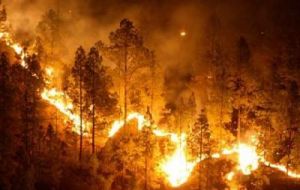MercoPress. South Atlantic News Agency
The year 2009 to rank among the top 10 warmest on record since 1850
 Extreme warm events, --droughts and forest fires--, were more frequent and intense in southern South America and Australia
Extreme warm events, --droughts and forest fires--, were more frequent and intense in southern South America and Australia The year 2009 is likely to rank in the top 10 warmest on record since the beginning of instrumental climate records in 1850, according to data sources compiled by the World Meteorological Organization (WMO).
The current nominal ranking of 2009, which does not account for uncertainties in the annual averages, places it as the fifth-warmest year. The decade of the 2000s (2000–2009) was warmer than the decade spanning the 1990s (1990–1999), which in turn was warmer than the 1980s (1980–1989).
This year above-normal temperatures were recorded in most parts of the continents. Only North America (United States and Canada) experienced conditions that were cooler than average. Given the current figures, large parts of southern Asia and central Africa are likely to have the warmest year on record.
Climate extremes, including devastating floods, severe droughts, snowstorms, heat-waves and cold waves, were recorded in many parts of the world. This year the extreme warm events were more frequent and intense in southern South America, Australia and southern Asia, in particular.
La Niña conditions shifted into a warm-phase El Niño-Southern Oscillation (ENSO) in June.
The Arctic sea ice extent during the melt season ranked the third lowest, after the lowest and second-lowest records set in 2007 and 2008, respectively.
This preliminary information for 2009 is based on climate data from networks of land-based weather and climate stations, ships and buoys, as well as satellites. The data are continuously collected and disseminated by the National Meteorological and Hydrological Services (NMHSs) of the 189 Members of WMO and several collaborating research institutions.
The year 2009 (January–October) was again warmer than the 1961–1990 average all over Europe and the Middle East. China had the third-warmest year since 1951; for some regions 2009 was the warmest year.
The year started with a mild January in northern Europe and large parts of Asia, while western and central Europe were colder than normal. Russia and the Great Lakes region in Canada experienced colder-than- average temperatures in February and January, respectively. Spring was very warm in Europe and Asia; April in particular was extremely warm in central Europe. Germany, the Czech Republic and Austria reported temperature anomalies of more than +5°C, breaking the previous records for the month in several locations. The European summer was also warmer than the long-term average, particularly over the southern regions. Spain had the third-warmest summer, with hotter summers reported only in 2003 and 2005. Italy recorded a strong heatwave in July, with maximum temperatures above 40°C, and some local temperatures reaching 45°C. A heatwave at the beginning of July affected the United Kingdom, France, Belgium and Germany, and some stations in Norway experienced new maximum temperature records.
The austral autumn (March to May) was extremely warm in Argentina, Uruguay, Paraguay and southern Brazil. With daily temperatures ranging from 30°C to 40°C, several records were broken during this season.
By the end of October, an extreme weather situation affected north and central Argentina, producing unusually high temperatures (above 40°C). Conversely, November was abnormally cold in the southern part of the region, with some rare and late snowfalls.
So far, Australia has had the third-warmest year on record. The year 2009 was marked by three exceptional heatwaves, which affected south-eastern Australia in January/February and November, and subtropical eastern Australia in August. The January/February heatwave was associated with disastrous bushfires that caused more than 173 fatalities. Victoria recorded its highest temperature with 48.8°C.
China suffered its worst drought in five decades. Water levels in parts of the Gan River and Xiangjiang River were the lowest in the past 50 years. In India the poor monsoon season caused severe drought impacts in 40 per cent of the districts. The north-western and north-eastern parts of the country were badly affected. It was reported to be one of the weakest monsoon seasons since 1972.
In North America, Mexico experienced severe-to-exceptional drought conditions by the month of September. In the United States, the western region was the most affected by a moderate-to-exceptional drought by the end of October. Nevertheless, the total area affected by drought in the United States during October was the second-smallest value recorded in this decade.
Drought in Central Argentina caused severe damage to agriculture, livestock and water resources. The situation was most severe at the end of October, with very high temperatures reported as well.


![“Working directly with President [Donald] Trump and Congress, we accomplished what no one else could,” Patel stressed](/data/cache/noticias/108417/130x80/fbi.jpg)

Top Comments
Disclaimer & comment rulesCommenting for this story is now closed.
If you have a Facebook account, become a fan and comment on our Facebook Page!